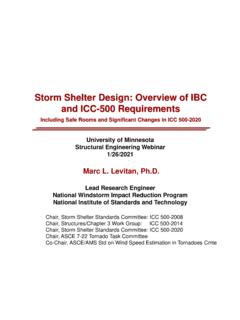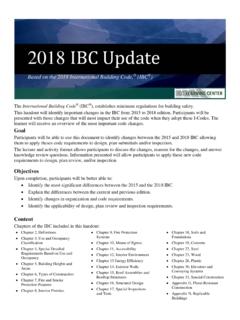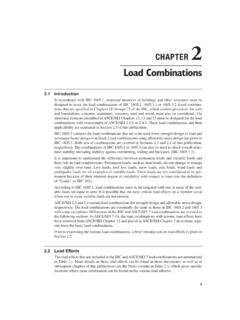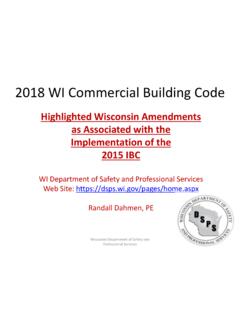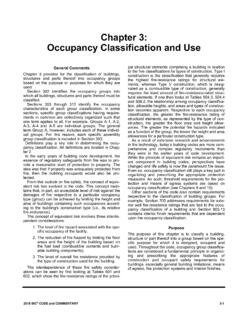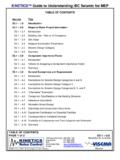Transcription of Guide to Fire Sprinkler Changes in the 2018 IFC, IBC, IRC ...
1 Guide to fire Sprinkler Changes in the 2018 IFC, IBC, IRC and IEBCby Jeffrey M. Hugo, CBONFSA s Director of Codesand fire ProtectionGuide to fire Sprinkler Changes in the 2018 IFC, IBC, IRC and IEBCI ntroductionThis short Guide is compiled of several articles written by National fire Sprinkler Association s Director of Codes and Public fire Protection, Jeffrey M. Hugo, CBO, and reprinted from the National fire Sprinkler Magazine to highlight the Changes and new code requirements in the 2018 International Codes, such as the International fire Codes(IFC), International Building Code (IBC) International Existing Building Code (IEBC) and the International Residential Code (IRC). This Guide is prepared to assist jurisdictions, code officials, architects, engineers and contractors with the latest adoption and enforcement of the most recent and updated codes.
2 Table of Contents Significant Changes to the 2018 IFC, IBC, IRC and IEBC ..1 NFPA 13R Attic Protection Addressed in 2018 IBC and NFPA fire Sprinklers for Commercial Uses in Dwellings and Guide to Benefits of fire Sprinklers in the IRC From 2018 IFC chapter 32 A-2 Retrofit in the 2018 more information:Jeffrey M. Hugo, CBOemail: article summarizes the 21 most significant Changes for the fire Sprinkler industry in the new 2018 I Codes that are scheduled to be available mid-2017. Many of these Changes deserve more discussion. Some will be explained in-depth in fu-ture issues. It is important to note that this article is put together from the proposals the ICC member-ship accepted during the cycle. The code sections listed may change slightly when the code books are printed. However, the technical Changes remain and the NFSA membership stands to gain, again, from fully participating in the code development process.
3 Many Changes in the 2018 editions increase fire Sprinkler installations in new and existing construction and increase life safety and property protection. IFCFire Pump and fire Sprinkler Riser Rooms IFC/IBC section in the 2018 IFC for rooms that house fire sprinklerrisers and fire pumps is expanding. What s new is fire pumps,controllers and risers shall be readily accessible within the roomand to those who access the room. If the room has a lock, then the key needs to be always available to those who need to access theroom. Signage is required on the access doors to fire pump and riser rooms and shall consist of letters at least two inches in height. fire pump and riser rooms shall be maintained to be no lower than 40 degrees Fahrenheit, with the heating device permanently installed. Permanent artificial lighting is now required to be installed by the 2018 Testing IFC/IBC 4 is a new standard for testing integrated fire protection and life safety systems.
4 The 2018 IFC/IBC will reference the 2015 NFPA 4 for integrated testing on high-rise buildings and when a fire alarm system is integrated with a smoke control system. For all other buildings, when two or more fire protection or life safety systems are integrated, the IFC/IBC only requires verification that the integrated systems signal, when initiated. It is important to highlight that these systems (other than high-rise and those connected to smoke control) are not required to comply or follow the procedures in NFPA 4. Ambulatory Care Facilities IFC/IBC care facilities first became an occupancy and required to be sprinklered in the 2009 IFC/IBC. A Sprinkler system is required throughout the floor where the facility is located and extended down to the nearest level of exit discharge. The 2018 IFC/IBC is increasing the fire Sprinkler system to include all floors below the level of exit discharge, unless the floors are an open parking garage.
5 There are many scenarios and structures where the nearest level of exit discharge has several floors beneath it. This change will Sprinkler the remaining floors below the ambulatory care facility regardless of the occupancy. According to 2017 Dodge Construction Outlook, ..the rise of offsite health clinics and the growing need to serve an aging population will also contribute to growth in 2017. Education Occupancies IFC/IBC 2018 IFC/IBC provides an additional threshold for fire sprinklers in education occupancies. Currently the trigger for fire sprinklers is fire areas over 12,000 sq. ft. and floors under the lowest level of exit discharge. In 2018 , any fire area that exceeds a 300-person occupant load and any floor other than the floor on the level of exit discharge requires fire sprinklers. The fire code committee and membership agreed it was time to increase the threshold for educational facilities because of security and egress needs, such as locking devices and lockdown practices that use a protect-in-place strategy.
6 According to 2017 Dodge Construc-tion Outlook, ..educational facilities is seeing an increasing amount of K-12 school construction, supported by the passage of recent school construction bond with a projected +9% in starts and 138 million square feet in Protection for NFPA 13R Protected Structures IFC/IBC 2018 IFC/IBC contains additional criteria for attics inresidential occupancies protected by NFPA 13R systems. TheseNFSMCODE CORNERS ignificant Changes to the 2018 IFC, IBC, IRC and IEBCby Jeff Hugo, CBO, NFSA s Manager of Codescontinued on page 24 March/April 2017 | 12 | National fire Sprinkler Magazinerequirements stem from the 2015 NFPA 13R Summit hosted by NFPA, written about by myself, Roland Asp and Russ Fleming in the Mar/Apr 2016 issue of SQ. The technical Changes to the 2018 IFC/IFC were explained in great detail in the Jan/Feb 2017 issue of the National fire Sprinkler Magazine.
7 In summary, the Changes require sprinklers in occupied attics and attics used for storage, and a single Sprinkler when fuel-fired appliances are in-stalled. The biggest change is for pedestal or podium type buildings where the attic is over 55 feet from the lowest level of required fire department vehicle access. When this height is exceeded, the attic is required to have fire sprinklers, or the attic can be constructed of fire -retardant-treated wood or of non-combustible materials, or filled entirely with non-combustible insulation. Occupant Hose Lines IFC/IBC of occupant hose lines for Class III standpipes has been in the IFC for a few cycles. However, the IBC and IFC created a paradox, meaning, the IBC requires the Class III hose when built, then the IFC permits it to be removed if the occupants are not trained to use the hose. This change in 2018 IFC/IBC will permit the code official to waive the hose line requirement before construction.
8 Furthermore, another change to this section permits B and E occupancies to have Class I standpipe systems. Maintenance and Testing of Smoke and Heat Vents IFC and heat vents, like other fire protection devices, need tobe inspected, maintained and tested on a regular basis to ensureproper operation. The change better correlates the IFC and NFPA204 to provide the code official with needed information for theinspection, testing and maintenance of these devices. However,rather than testing all smoke and heat vents annually as NFPA204 requires, this change revises the IFC testing requirement ofsmoke and heat vents to once every 5 A-2 Occupancies with Sprinklers IFC 2018 IFC will require A-2 occupancies with fire areas hav-ing more than 300 occupants consuming alcohol to retrofit withsprinklers. This requirement, in part, comes from Recommenda-tion #1 of the NIST Report of the Technical Investigation of The Station Nightclub fire .
9 This requirement is not a blanket A-2retrofit, but only those A-2 fire areas where alcohol is consumedthat exceed 300 occupants will require fire sprinklers. Accordingto in the past few years, over 1,400 oc-cupants, in only five establishments, were saved by fire sprinklerswhen they activated during operating hours. One nightclub,with another 600 occupants, had two fires in the past two years!Sprinklers controlled both Buildings using Tents and Membrane Structures IFC and other membrane structures have become a popular op-tion for temporary special amusement buildings. One reason is that the IFC and IBC did not tie together the Sprinkler requirements. This change points the user of the IFC to the amusement building Sprinkler requirement in IBC Section 411. This Changes closes a loophole and will increase occupant safety without introducing the more burdensome requirements of Section 411.
10 The IBC permits an approved temporary water supply, providing some flexibility to Sprinkler installations. High-Piled Storage IFC chapter 32 NFSA staff and several members were involved in ICC s fire Code Action Committee s (FCAC) task group to make over 14 different proposals to change and update the 2018 IFC chapter 32. An article for the Nov/Dec, 2015 edition of SQ, titled, Classifying Commodities in IFC chapter 32 and NFPA 13 explained the largest change to the chapter on the correlation of classification of commodities. The reason for the several Changes is primarily to update the chapter and correlate it with NFPA 13 and the new technologies that have occurred since the 2000 edition. Look for future articles explaining more specific details of the reworked chapter . Laboratories IFC chapter 38 and IBC 427 The 2018 IFC has a new chapter on higher education laborato-ries.


